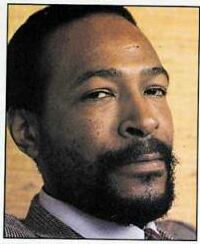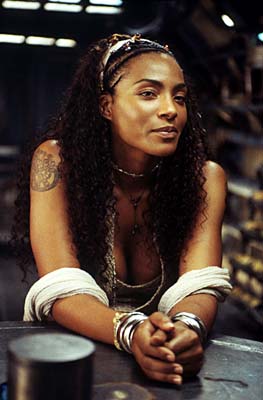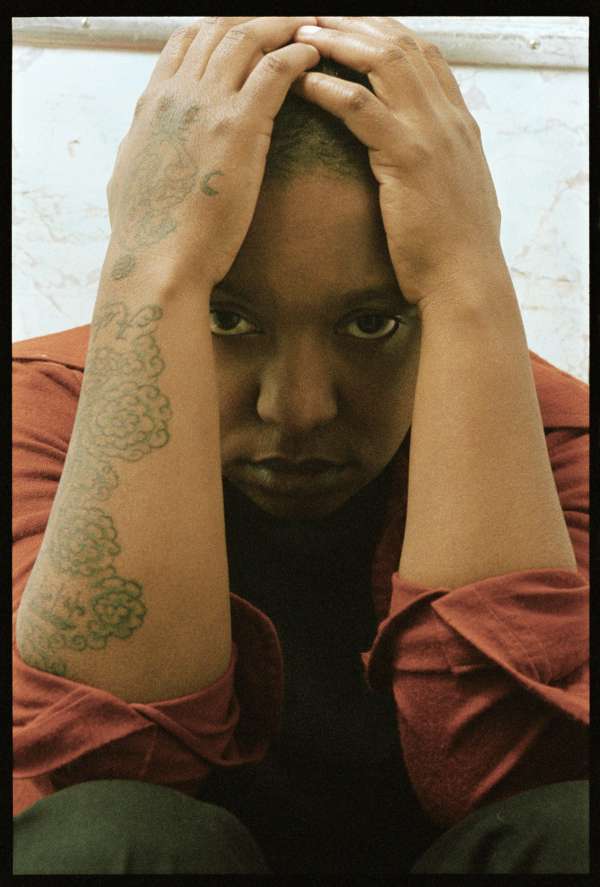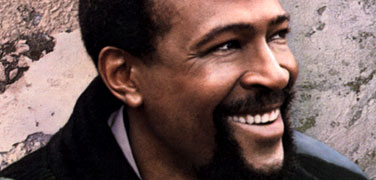MARVIN GAYE / “Inner City Blues”
Berry Gordy hated the single (“What’s Going On”). He said it was the worst thing he’d ever heard – “All that Dizzy Gillespie music up in there. You’re a sex symbol. Why you wanna be a protest singer?” Marvin told [Gordy] that if he didn’t release the song, he wasn’t making any more music [for Motown]. They were at a stalemate for six months – that’s back then, now it ain’t [nothing]. Marvin didn’t make music for a year and a half. Back then that was a huge gap in an artist’s itinerary. Marvin held out and finally they released the song, but without Berry Gordy’s permission. Berry hit the ceiling. But by the time the vice-president [of Motown] left Detroit and got to L.A., to explain it to Gordy, who had moved there to live, the song had sold 100,000 copies and Berry was quite happy! After that, Marvin sat down to work on the album and finished it in 10 days. That’s unbelievable! Arguably the greatest album of American popular music was made in 10 days. —Micheal Eric Dyson, author of “Mercy, Mercy Me: The Art, Loves & Demons of Marvin Gaye”Most fans of soul music—yours truly included—believe What’s Going On is the greatest soul album ever recorded. I don’t think it’s musically stronger than Stevie Wonder at his prime or, for that matter, Mayfield’s massive Superfly soundtrack, nevertheless, Marvin tapped into something the others didn’t: a straight-up political reflection of the times. Based on the experiences of his brother upon returning home from Vietnam, Marvin Gaye laid down the total 411 with nary a nod to either the constrictions of the dance floor or the restrictions of radio. By now most of us have heard and laughed heartily about Berry Gordy not wanting to release What’s Going On, and about Marvin threatening to quit. One of the hit singles, Inner City Blues, was the dark sound of young America, a sound Gordy was certain wouldn’t fit into heavy rotation on American Bandstand. This, after all, was when the Supremes were at their commercial peak and the Temptations were tearing up the charts; Berry wanted Motown to produce the ultimate in lucrative American pop music. In many ways, Gordy was right about What’s Going On being out of step with Motown’s crossover dreams, but in an essential way, Gordy was dead wrong about the music’s potential popular appeal.
 When Gordy heard what Marvin had been up to all those midnights spent in the studio, he blanched. Marvin had been groomed to be Mr. Smooth, a black Sinatra, the second coming of Nat King Cole, an apolitical, musical Don Juan, and here he came with this anti-war, quasi-religious, save-the-babies, save-the-earth melodious screed. Look at the cover: the man is standing in the rain! Who would dance to this?
When it was finally released, our whole generation danced, and subsequent generations also danced. Marvin was right, Gordy was wrong. And now we get to hear the clinching argument: the live concert recording of What’s Going On. Initially I never paid any attention to the reissue because I though I already knew What’s Going On. I already had the CD (and the LP!), so there was no reason to get the Deluxe Edition, except there was one big-ass reason to get it: the live concert.
What’s Going On - Deluxe Edition is essential for any collection of soul music, as well as, for that matter, any collection of modern American music. The Deluxe Edition not only includes the live concert, but also the initial, pre-release mix and some session work and demos that lead up to the the final release. All in all, what we get is evidence that What’s Going On was the masterpiece in Marvin’s crown as a composer of serious music. When I heard the live session, I almost lit a candle on Berry Gordy (and in New Orleans that is not necessarily a good thing). How could Motown sit on this for so long? The concert is superb.
Jazz composer and bassist Charles Mingus was known to make his band start over when he felt they weren’t doing right by the music. Similarly, Marvin stops his band several times during the live performance, insisting on getting the right groove. We get to hear the whole concert, warts and all, and what beautiful ugliness the musical miscues are—to hear a man clean up his mistakes (even though, to tell the truth, it was all sounding good to me), it’s like being present at the creation. Moreover, you can literally hear the subtle differences each time Marvin pushes the band for more.
What we have here are not just a few unreleased takes—no we’re talking the whole enchilada, plus a concert recording, in addition to the original release—shit, I ought to light two candles and stick a couple of pins in the doll as payback for Gordy making us wait close to thirty years to hear this awesome music.
I had my doubts when I heard about the recording. After all, Marvin had spent literally months overdubbing and arranging the single. He multi-tracked his voice. How in the world would he do What’s Going On live? Oh me of little faith! But don’t take my word for it; get the Deluxe Edition and hear it all for yourself.
When Gordy heard what Marvin had been up to all those midnights spent in the studio, he blanched. Marvin had been groomed to be Mr. Smooth, a black Sinatra, the second coming of Nat King Cole, an apolitical, musical Don Juan, and here he came with this anti-war, quasi-religious, save-the-babies, save-the-earth melodious screed. Look at the cover: the man is standing in the rain! Who would dance to this?
When it was finally released, our whole generation danced, and subsequent generations also danced. Marvin was right, Gordy was wrong. And now we get to hear the clinching argument: the live concert recording of What’s Going On. Initially I never paid any attention to the reissue because I though I already knew What’s Going On. I already had the CD (and the LP!), so there was no reason to get the Deluxe Edition, except there was one big-ass reason to get it: the live concert.
What’s Going On - Deluxe Edition is essential for any collection of soul music, as well as, for that matter, any collection of modern American music. The Deluxe Edition not only includes the live concert, but also the initial, pre-release mix and some session work and demos that lead up to the the final release. All in all, what we get is evidence that What’s Going On was the masterpiece in Marvin’s crown as a composer of serious music. When I heard the live session, I almost lit a candle on Berry Gordy (and in New Orleans that is not necessarily a good thing). How could Motown sit on this for so long? The concert is superb.
Jazz composer and bassist Charles Mingus was known to make his band start over when he felt they weren’t doing right by the music. Similarly, Marvin stops his band several times during the live performance, insisting on getting the right groove. We get to hear the whole concert, warts and all, and what beautiful ugliness the musical miscues are—to hear a man clean up his mistakes (even though, to tell the truth, it was all sounding good to me), it’s like being present at the creation. Moreover, you can literally hear the subtle differences each time Marvin pushes the band for more.
What we have here are not just a few unreleased takes—no we’re talking the whole enchilada, plus a concert recording, in addition to the original release—shit, I ought to light two candles and stick a couple of pins in the doll as payback for Gordy making us wait close to thirty years to hear this awesome music.
I had my doubts when I heard about the recording. After all, Marvin had spent literally months overdubbing and arranging the single. He multi-tracked his voice. How in the world would he do What’s Going On live? Oh me of little faith! But don’t take my word for it; get the Deluxe Edition and hear it all for yourself.
 And, oh yeah, I got some lagniappe for you: Marvin’s daughter on an otherwise forgettable Marvin Gaye tribute release. After appearances as Ali’s second wife in the bio-flick Ali, as Zee in The Matrix (Parts 2 and 3) and as the D.A.’s assistant/mistress in Crash, Nona is best known as an actress, but she also has an active career as a model and as a singer, a new recording soon come. Nona recorded a hip version of Inner City Blues (it's in the jukebox).
—Kalamu ya Salaam
Quote from Reel Images’ “An Interview with Michael Eric Dyson”: http://www.reelimagesmagazine.com/txt_reviews/reelreview_lit.htm
Click here to purchase What's Going On Deluxe Edition
And, oh yeah, I got some lagniappe for you: Marvin’s daughter on an otherwise forgettable Marvin Gaye tribute release. After appearances as Ali’s second wife in the bio-flick Ali, as Zee in The Matrix (Parts 2 and 3) and as the D.A.’s assistant/mistress in Crash, Nona is best known as an actress, but she also has an active career as a model and as a singer, a new recording soon come. Nona recorded a hip version of Inner City Blues (it's in the jukebox).
—Kalamu ya Salaam
Quote from Reel Images’ “An Interview with Michael Eric Dyson”: http://www.reelimagesmagazine.com/txt_reviews/reelreview_lit.htm
Click here to purchase What's Going On Deluxe Edition Wah-Wah came to fame as the man who provided those rubbery guitar riffs on latter-day Motown releases including the Temptations’ “Papa Was A Rolling Stone” and Marvin Gaye’s “I Want You” (the 1976 release that followed “What’s Going On”). Wah Wah also performs on hundreds of other significant recordings by the likes of Barry White, Quincy Jones, Herbie Hancock, the Pointer Sisters, Rose Royce’s “Carwash,” Michael Jackson’s “Off The Wall,” and (I kid you not) Bill Cosby’s 1976 release “Bill Cosby Is Not Himself These Days.”
When you get right down to charting the interconnections, it makes you want to holler. And as for Gil’s remake, he agrees with me: it makes you want to holler, except he was talking about social conditions then and (sort of prophet-like) now.
—Kalamu ya Salaam
It ain’t pretty in the inner city
That Meshell song is truly depressing. I like it—but its hard to listen to. I didn't know Meshell was on the Nona Gaye remake (you meant reMAKE not reMIX, I'm assuming), but that would account for the funkiness and musicality of it.
As for the Gil Scott-Heron version, I grew up hearing Marvin's song and Gil's version, but I don't recall associating them. In other words, Gil's version has a strong enough presence that it doesn't seem to be the same song.
Wah-Wah came to fame as the man who provided those rubbery guitar riffs on latter-day Motown releases including the Temptations’ “Papa Was A Rolling Stone” and Marvin Gaye’s “I Want You” (the 1976 release that followed “What’s Going On”). Wah Wah also performs on hundreds of other significant recordings by the likes of Barry White, Quincy Jones, Herbie Hancock, the Pointer Sisters, Rose Royce’s “Carwash,” Michael Jackson’s “Off The Wall,” and (I kid you not) Bill Cosby’s 1976 release “Bill Cosby Is Not Himself These Days.”
When you get right down to charting the interconnections, it makes you want to holler. And as for Gil’s remake, he agrees with me: it makes you want to holler, except he was talking about social conditions then and (sort of prophet-like) now.
—Kalamu ya Salaam
It ain’t pretty in the inner city
That Meshell song is truly depressing. I like it—but its hard to listen to. I didn't know Meshell was on the Nona Gaye remake (you meant reMAKE not reMIX, I'm assuming), but that would account for the funkiness and musicality of it.
As for the Gil Scott-Heron version, I grew up hearing Marvin's song and Gil's version, but I don't recall associating them. In other words, Gil's version has a strong enough presence that it doesn't seem to be the same song.
* * *
 Kalamu asked me to elaborate on why I find the Meshell song so depressing. It's because there is nothing 'artful' (intentionally, I'm sure) about the piece. Meshell is speaking (not reciting, not singing—speaking; speaking just as calmly and matter-of-fact as if she were your acquaintance and you were sitting across from her at a dark table in the back corner of a restaurant) and what's she's speaking about is the ugliness of her parents' relationship. It’s probably been a couple of years since I’ve heard the song, but I can easily recall some of Meshell’s phrases: "My mother used to whore herself"; "My father was vindictive in his own fashion"; "For me, there was no sympathy," and so on. It's a cold, cold piece of spoken-word laid over a warm groove; I'd like to like it more but it's just not likeable. Of course, everything in life (or music) doesn't have to be ‘likeable,’ but that one's too raw for me.
—Mtume ya Salaam
Fascinated by the flame
Mtume, one person’s poison is another person’s purgative.
Like I said, I had the opportunity to hear her do it live—it was a show-stopper. Talk about some blues, some real, hard, inner city blues. That’s when I became a Meshell fan, and elevated her to jazz hero status, meaning the music was a personal statement that had ramifications for both the artist and the audience.
Kalamu asked me to elaborate on why I find the Meshell song so depressing. It's because there is nothing 'artful' (intentionally, I'm sure) about the piece. Meshell is speaking (not reciting, not singing—speaking; speaking just as calmly and matter-of-fact as if she were your acquaintance and you were sitting across from her at a dark table in the back corner of a restaurant) and what's she's speaking about is the ugliness of her parents' relationship. It’s probably been a couple of years since I’ve heard the song, but I can easily recall some of Meshell’s phrases: "My mother used to whore herself"; "My father was vindictive in his own fashion"; "For me, there was no sympathy," and so on. It's a cold, cold piece of spoken-word laid over a warm groove; I'd like to like it more but it's just not likeable. Of course, everything in life (or music) doesn't have to be ‘likeable,’ but that one's too raw for me.
—Mtume ya Salaam
Fascinated by the flame
Mtume, one person’s poison is another person’s purgative.
Like I said, I had the opportunity to hear her do it live—it was a show-stopper. Talk about some blues, some real, hard, inner city blues. That’s when I became a Meshell fan, and elevated her to jazz hero status, meaning the music was a personal statement that had ramifications for both the artist and the audience.
 I was fascinated by the flame, never once wanted to turn away or pretend she wasn’t burning, which says something about my personality. Meshell’s presentation reveals a lot about both the artist who produces it and the audience who digs (or is repulsed by) it. Meshell went deep inside the mirror on that one, whereas Gil turned the telescope on society and examined an ugly reality: just two sides of the inner city blues, the internal and the external. Makes you wannna holla.
With that said, tell me what you think about the four different versions of Inner City Blues that Marvin did: 1. as originally released, 2. as first mixed but previously unreleased, 3. the first live cut, and 4. the encore live cut.
—Kalamu ya Salaam
How many ways can you holler?
The four different versions are fascinating in that they are similar yet they each left me with a different feeling. I'd say my favorites are the original, as-released LP version and the reprised concert version. The Detroit Mix opens very nicely, with the exaggerated congas and rhythm section, but the rest of it sounds like a duller mix of the famous version. The first live version is very cool. The way Marvin stops the band and gets everybody—including the string section with whom he'd never worked—to begin from 'letter A' is priceless. But the one I really like is the reprise. Marvin sings the lyrics in a wistful falsetto and ends the tune with an ad-libbed blessing to the audience.
I was fascinated by the flame, never once wanted to turn away or pretend she wasn’t burning, which says something about my personality. Meshell’s presentation reveals a lot about both the artist who produces it and the audience who digs (or is repulsed by) it. Meshell went deep inside the mirror on that one, whereas Gil turned the telescope on society and examined an ugly reality: just two sides of the inner city blues, the internal and the external. Makes you wannna holla.
With that said, tell me what you think about the four different versions of Inner City Blues that Marvin did: 1. as originally released, 2. as first mixed but previously unreleased, 3. the first live cut, and 4. the encore live cut.
—Kalamu ya Salaam
How many ways can you holler?
The four different versions are fascinating in that they are similar yet they each left me with a different feeling. I'd say my favorites are the original, as-released LP version and the reprised concert version. The Detroit Mix opens very nicely, with the exaggerated congas and rhythm section, but the rest of it sounds like a duller mix of the famous version. The first live version is very cool. The way Marvin stops the band and gets everybody—including the string section with whom he'd never worked—to begin from 'letter A' is priceless. But the one I really like is the reprise. Marvin sings the lyrics in a wistful falsetto and ends the tune with an ad-libbed blessing to the audience.
 Two things to listen for: there's a revealing moment in the middle of the first verse (of the reprise) when Marvin drops the falsetto for a moment to tell the band "Don't run with me!"—i.e., just keep the groove, don't increase the tempo. It's revealing because Marvin sings so often in the falsetto voice that you start thinking it's his natural pitch. The other moment is when the song is over. The moment the band stops, Marvin says, "'What's Going On,'" calling for the next song. The audience tries to applaud but Marvin gives them only the briefest of thank yous, then repeats: "'What's Going On,' gentlemen." As the liner notes explain, Marvin wasn't blowing off the audience—he was scared. And tired. And stoned. As Marvin himself put it, "It was a struggle for us. But I feel pretty good about it." As you should, Marvin. As you should.
—Mtume ya Salaam
Two things to listen for: there's a revealing moment in the middle of the first verse (of the reprise) when Marvin drops the falsetto for a moment to tell the band "Don't run with me!"—i.e., just keep the groove, don't increase the tempo. It's revealing because Marvin sings so often in the falsetto voice that you start thinking it's his natural pitch. The other moment is when the song is over. The moment the band stops, Marvin says, "'What's Going On,'" calling for the next song. The audience tries to applaud but Marvin gives them only the briefest of thank yous, then repeats: "'What's Going On,' gentlemen." As the liner notes explain, Marvin wasn't blowing off the audience—he was scared. And tired. And stoned. As Marvin himself put it, "It was a struggle for us. But I feel pretty good about it." As you should, Marvin. As you should.
—Mtume ya Salaam
This entry was posted on Sunday, June 26th, 2005 at 12:01 am and is filed under Classic. You can follow any responses to this entry through the RSS 2.0 feed. You can leave a response, or trackback from your own site.
9 Responses to “MARVIN GAYE / “Inner City Blues””
June 20th, 2005 at 2:28 am
Hi Kalamu,
This is a really nice site! Glad to see Marvin Gaye!
In spite of what the author says, Marvin charted every year from 1962 to 1979, with the exception of the year 1975. (There was a gap after the last charted song ‘Distant Lover’ #15 on Sept 28, 1974 until April 24 1976 ‘I Want You’ which went to #15.) Then in 1982 ‘Sexual Healing’ (Columbia records) #3 Oct 1982+.
It was very common for artists to cut tracks and have the producer shelve them because they didn’t like ’em and didn’t think they were good enough..until many months later. Pressing and distribution costs and keeping a close watch on what tunes were selling were all taken into consideration very seriously! Other costs (greasing DJs we won’t mention).
Incidentally, Marvin was a sessions drummer for Motown before he recorded under his own name in 1961. He was also a member of The Marquees and The Rainbows and then The Moonglows. He married Berry Gordy’s sister, Anna (you may remember the ‘Anna’ Record label run by Billy Davis and Gwen Gordy in Detroit..or maybe not!).
Anyway, just thought you’d want to know. Marvin’s death was a huge loss!
Thank you!
Anita
* * * Mtume says: Speaking of Anna Gordy, my favorite Marvin Gaye album is Here, My Dear, a 2-LP set of spite, vitriol, incrimination and recrimination that Marvin was court-ordered to record in order to pay Anna’s $1,000,000 divorce settlement. Under similar circumstances, the average musician would’ve recorded a quick collection of filler and forgotten about the whole thing. Not Marvin. Here, My Dear is a 14-song break-up letter set to the most melancholy funk you’ve ever heard. It’s an opening argument, a cross examination, a closing argument, a conviction and a sentencing hearing, all in one. It’s strange and savage and petty and pretty and — given Marvin’s stature at that time as a major pop star — damn near unbelievable. Sample lyrics: “Could someone tell me, please / Why do I have to pay attorney fees? / This is a joke / I need a smoke.” Classic, classic Marvin. * * *
June 26th, 2005 at 10:26 am
Wow, a fantastic site you guys have put together here. I can’t wait to be a regular reader!
I just wanted to add my brief 2 cents and say that the live version of “What’s Goin On” on that Deluxe Edition is simply MIND BLOWING. That has to be one of the best live vocal performances I’ve ever heard, with Marvin’s voice diving up and down between the album vocal and some creative harmony vocals. I used to manage a record store and every time that version came on, heads turned and special orders were made by the truckload.
Thanks for your site. Great work.
June 27th, 2005 at 4:28 pm
Mtume,
It disturbs me the extent to which I like “Here, My Dear.” Makes me feel like a bastard just for liking it. Let me correct that, for loving it! “What I can’t understand is if you love me, how could you / turn me in to the police?” Has there ever been a more self-centered piece of music that’s, as you suggest, so incredibly funky? Man. Just the arrogance it takes to record that whole thing.
Listening to the recording one gets the impression that Marvin could have used the help of a therapist, but I’m big enough to admit that I’m selfish. I’m glad he didn’t go to a shrink before he did this album. Because he says all those things we want to say to our exes, he’s as petty as we all want to be, and even as he sings “Hallelujah, I’m free,” he’s still presenting her with the song he always promised her. Lots of artists SAY that they’re conflicted in their songs and on their albums, but I don’t know that anybody else has shown it the way he did on “Here, My Dear.”
I’ve always been jealous of his passion, his ability to say it all — regardless of propriety.
– Jarvis
June 29th, 2005 at 3:24 am
As far as black music goes …Marvin is king and even generations from now …marvin will still be the man
June 30th, 2005 at 4:56 am
when whats going on came out
July 2nd, 2005 at 3:54 pm
On the Retake. Initially I thought in the first several bars or so either he or the band or both were out of tune. It seemed to smooth out as they went on. But then he decided to go back.
There are some songs just can’t be covered. His daughters’s (Nona’s) effort captures some of the passion of her father. But Marvin is so powerful though at times singing falsetto. He just keeps changing the tonal qualities of his voice. That a kind of dynamic is generated. The Gil-Scott version doesn’t work for me. Their styles are just too far apart. I did not like his rendition at all, though I thought it an interesting failure.
Marvin is the man and so it all goes down hill from there. I’m looking forward to what’s next.
Rudy
October 12th, 2005 at 12:08 pm
I would like to know what was Marvin Gaye thinking when he wrote the song Mercy Mercy Me.
The song is a very powerful with lots of evironmental issues and meaning.
October 8th, 2007 at 10:35 pm
Thanks for your comments about my ex-husband and my daughter…lovely.
July 21st, 2008 at 7:44 pm
what is the name of the song were he says " I need a smoke, this aint no joke"?
Mtume says
Your quote’s not exactly right, but the song is "Is That Enough" from Here, My Dear.
Leave a Reply
| top |